Improving Customer Experience: Strategic Recommendations for Unilever
VerifiedAdded on 2023/06/10
|9
|2951
|202
Report
AI Summary
This report provides a comprehensive analysis of customer experience at Unilever Plc, a UK-based company offering a wide range of goods. It examines Unilever's value proposition, detailing how the company aims to provide quality products at competitive prices, aligning with its vision of sustainable living. The report explores how Unilever delivers customer experience through superior product quality and advanced technologies, emphasizing six key pillars: inspire, entertain, inform, educate, help, and reward. It identifies Unilever's diverse customer base, ranging from children to the elderly, and explains how the company segments its markets to meet varied needs. The analysis includes a critical application of the Six Pillars of Customer Experience model—integrity, resolution, expectations, empathy, personalization, and time and effort—to Unilever's operations. Furthermore, the report addresses the implications of digital disruption, such as loyalty apps and e-receipts, on customer experience delivery. The report concludes with strategic recommendations for Unilever to enhance customer experience, ultimately benefiting both market share and organizational success.

Customer Experience
Paraphrase This Document
Need a fresh take? Get an instant paraphrase of this document with our AI Paraphraser
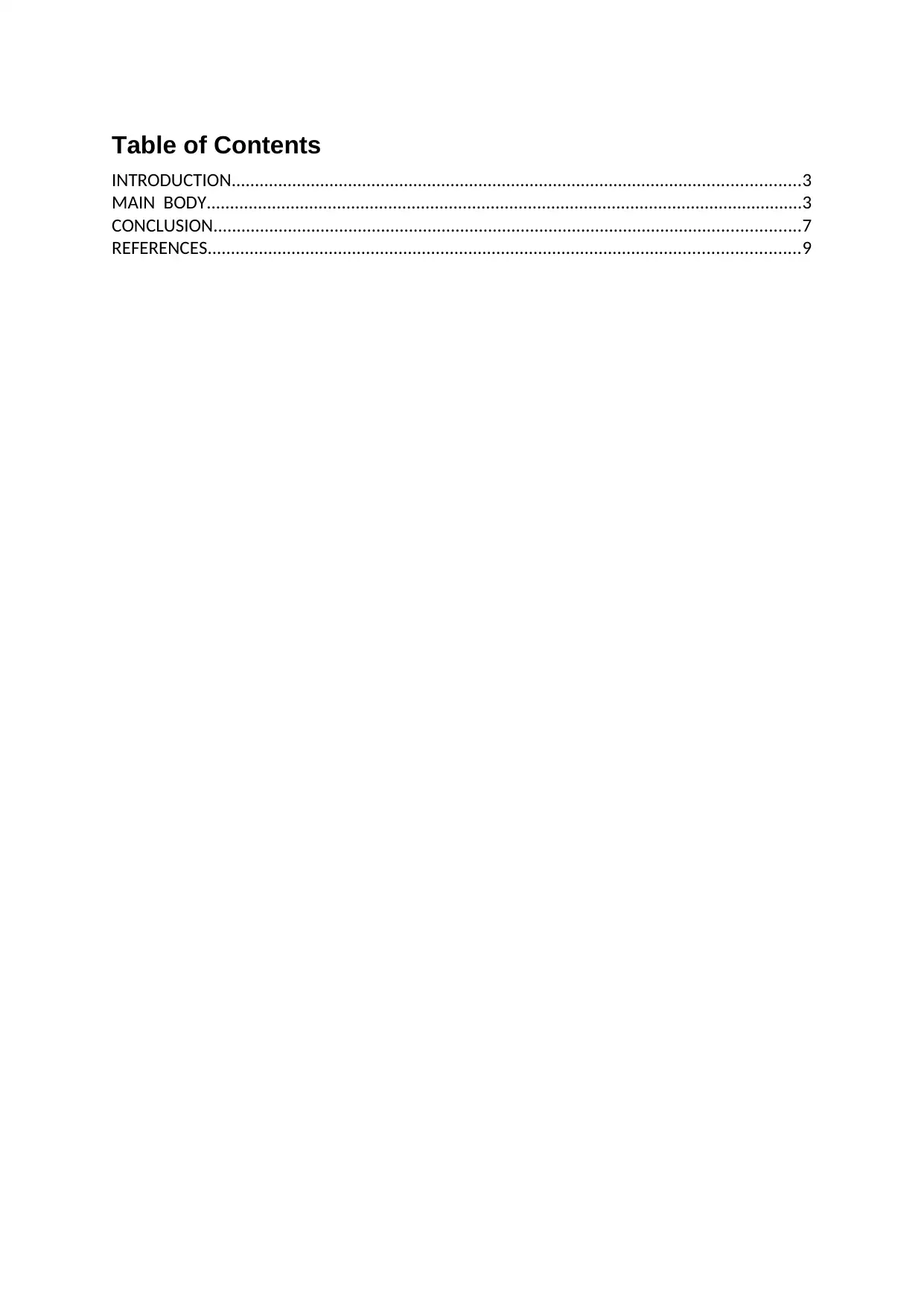
Table of Contents
INTRODUCTION..........................................................................................................................3
MAIN BODY................................................................................................................................3
CONCLUSION..............................................................................................................................7
REFERENCES...............................................................................................................................9
INTRODUCTION..........................................................................................................................3
MAIN BODY................................................................................................................................3
CONCLUSION..............................................................................................................................7
REFERENCES...............................................................................................................................9
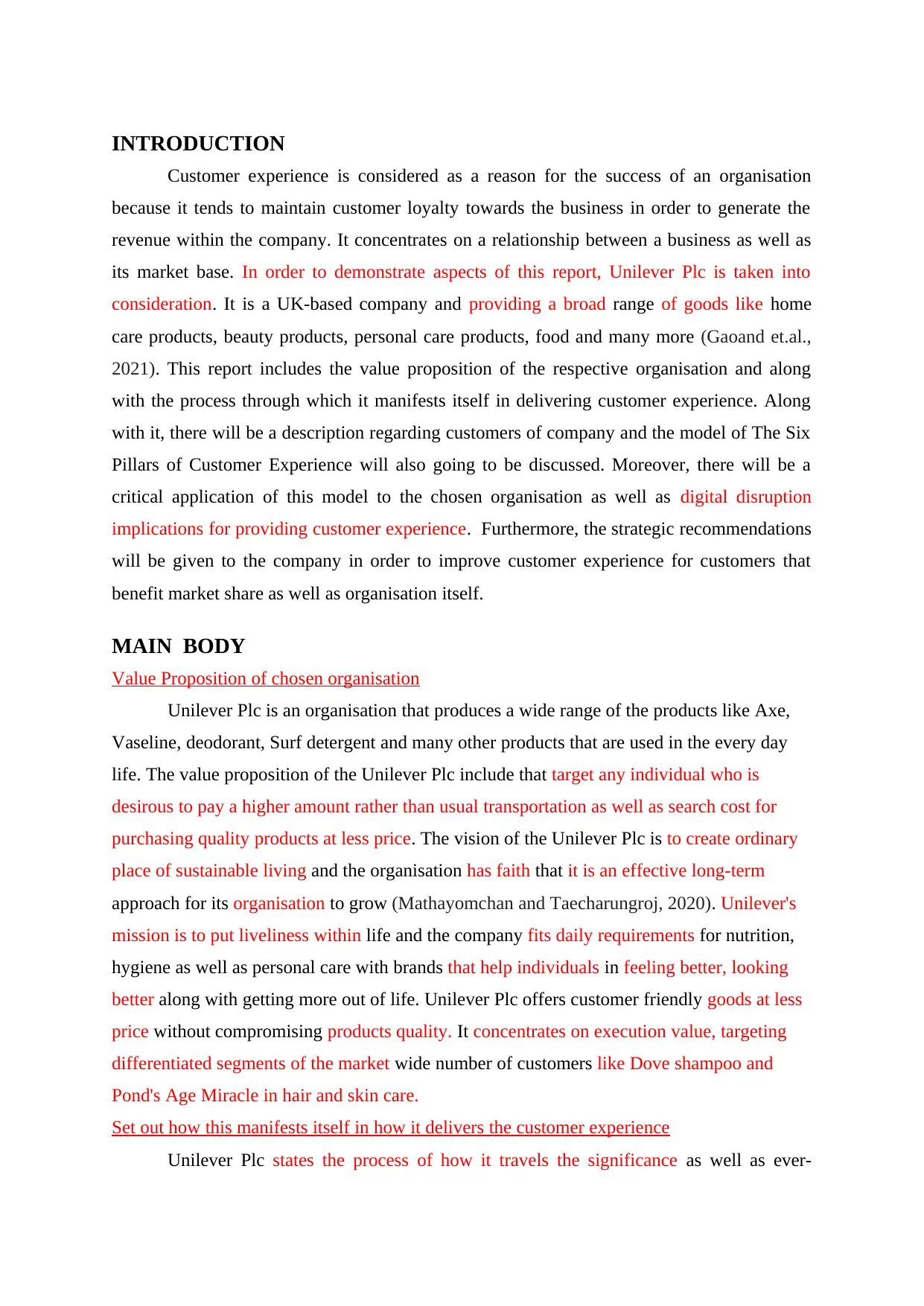
INTRODUCTION
Customer experience is considered as a reason for the success of an organisation
because it tends to maintain customer loyalty towards the business in order to generate the
revenue within the company. It concentrates on a relationship between a business as well as
its market base. In order to demonstrate aspects of this report, Unilever Plc is taken into
consideration. It is a UK-based company and providing a broad range of goods like home
care products, beauty products, personal care products, food and many more (Gaoand et.al.,
2021). This report includes the value proposition of the respective organisation and along
with the process through which it manifests itself in delivering customer experience. Along
with it, there will be a description regarding customers of company and the model of The Six
Pillars of Customer Experience will also going to be discussed. Moreover, there will be a
critical application of this model to the chosen organisation as well as digital disruption
implications for providing customer experience. Furthermore, the strategic recommendations
will be given to the company in order to improve customer experience for customers that
benefit market share as well as organisation itself.
MAIN BODY
Value Proposition of chosen organisation
Unilever Plc is an organisation that produces a wide range of the products like Axe,
Vaseline, deodorant, Surf detergent and many other products that are used in the every day
life. The value proposition of the Unilever Plc include that target any individual who is
desirous to pay a higher amount rather than usual transportation as well as search cost for
purchasing quality products at less price. The vision of the Unilever Plc is to create ordinary
place of sustainable living and the organisation has faith that it is an effective long-term
approach for its organisation to grow (Mathayomchan and Taecharungroj, 2020). Unilever's
mission is to put liveliness within life and the company fits daily requirements for nutrition,
hygiene as well as personal care with brands that help individuals in feeling better, looking
better along with getting more out of life. Unilever Plc offers customer friendly goods at less
price without compromising products quality. It concentrates on execution value, targeting
differentiated segments of the market wide number of customers like Dove shampoo and
Pond's Age Miracle in hair and skin care.
Set out how this manifests itself in how it delivers the customer experience
Unilever Plc states the process of how it travels the significance as well as ever-
Customer experience is considered as a reason for the success of an organisation
because it tends to maintain customer loyalty towards the business in order to generate the
revenue within the company. It concentrates on a relationship between a business as well as
its market base. In order to demonstrate aspects of this report, Unilever Plc is taken into
consideration. It is a UK-based company and providing a broad range of goods like home
care products, beauty products, personal care products, food and many more (Gaoand et.al.,
2021). This report includes the value proposition of the respective organisation and along
with the process through which it manifests itself in delivering customer experience. Along
with it, there will be a description regarding customers of company and the model of The Six
Pillars of Customer Experience will also going to be discussed. Moreover, there will be a
critical application of this model to the chosen organisation as well as digital disruption
implications for providing customer experience. Furthermore, the strategic recommendations
will be given to the company in order to improve customer experience for customers that
benefit market share as well as organisation itself.
MAIN BODY
Value Proposition of chosen organisation
Unilever Plc is an organisation that produces a wide range of the products like Axe,
Vaseline, deodorant, Surf detergent and many other products that are used in the every day
life. The value proposition of the Unilever Plc include that target any individual who is
desirous to pay a higher amount rather than usual transportation as well as search cost for
purchasing quality products at less price. The vision of the Unilever Plc is to create ordinary
place of sustainable living and the organisation has faith that it is an effective long-term
approach for its organisation to grow (Mathayomchan and Taecharungroj, 2020). Unilever's
mission is to put liveliness within life and the company fits daily requirements for nutrition,
hygiene as well as personal care with brands that help individuals in feeling better, looking
better along with getting more out of life. Unilever Plc offers customer friendly goods at less
price without compromising products quality. It concentrates on execution value, targeting
differentiated segments of the market wide number of customers like Dove shampoo and
Pond's Age Miracle in hair and skin care.
Set out how this manifests itself in how it delivers the customer experience
Unilever Plc states the process of how it travels the significance as well as ever-
⊘ This is a preview!⊘
Do you want full access?
Subscribe today to unlock all pages.

Trusted by 1+ million students worldwide
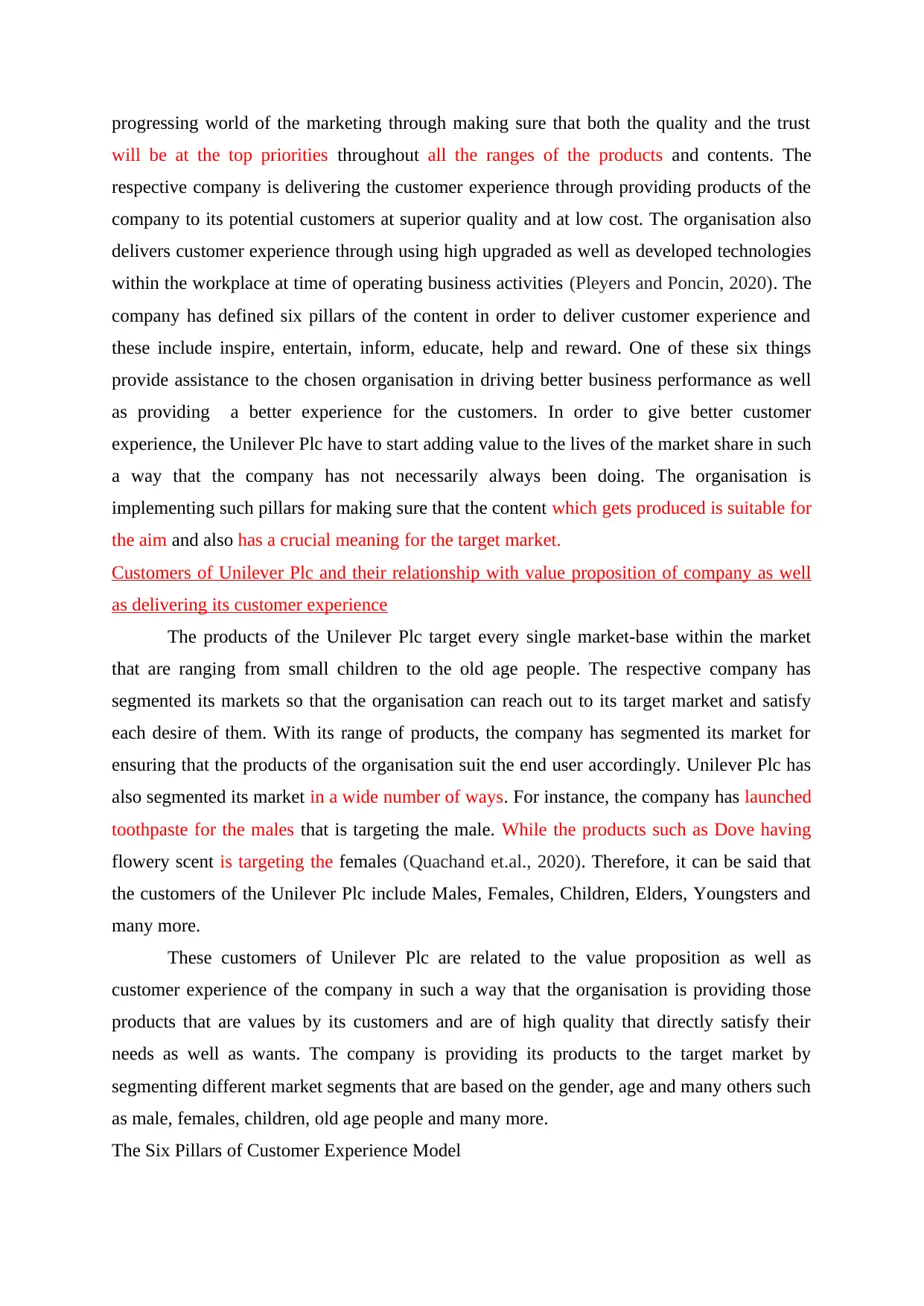
progressing world of the marketing through making sure that both the quality and the trust
will be at the top priorities throughout all the ranges of the products and contents. The
respective company is delivering the customer experience through providing products of the
company to its potential customers at superior quality and at low cost. The organisation also
delivers customer experience through using high upgraded as well as developed technologies
within the workplace at time of operating business activities (Pleyers and Poncin, 2020). The
company has defined six pillars of the content in order to deliver customer experience and
these include inspire, entertain, inform, educate, help and reward. One of these six things
provide assistance to the chosen organisation in driving better business performance as well
as providing a better experience for the customers. In order to give better customer
experience, the Unilever Plc have to start adding value to the lives of the market share in such
a way that the company has not necessarily always been doing. The organisation is
implementing such pillars for making sure that the content which gets produced is suitable for
the aim and also has a crucial meaning for the target market.
Customers of Unilever Plc and their relationship with value proposition of company as well
as delivering its customer experience
The products of the Unilever Plc target every single market-base within the market
that are ranging from small children to the old age people. The respective company has
segmented its markets so that the organisation can reach out to its target market and satisfy
each desire of them. With its range of products, the company has segmented its market for
ensuring that the products of the organisation suit the end user accordingly. Unilever Plc has
also segmented its market in a wide number of ways. For instance, the company has launched
toothpaste for the males that is targeting the male. While the products such as Dove having
flowery scent is targeting the females (Quachand et.al., 2020). Therefore, it can be said that
the customers of the Unilever Plc include Males, Females, Children, Elders, Youngsters and
many more.
These customers of Unilever Plc are related to the value proposition as well as
customer experience of the company in such a way that the organisation is providing those
products that are values by its customers and are of high quality that directly satisfy their
needs as well as wants. The company is providing its products to the target market by
segmenting different market segments that are based on the gender, age and many others such
as male, females, children, old age people and many more.
The Six Pillars of Customer Experience Model
will be at the top priorities throughout all the ranges of the products and contents. The
respective company is delivering the customer experience through providing products of the
company to its potential customers at superior quality and at low cost. The organisation also
delivers customer experience through using high upgraded as well as developed technologies
within the workplace at time of operating business activities (Pleyers and Poncin, 2020). The
company has defined six pillars of the content in order to deliver customer experience and
these include inspire, entertain, inform, educate, help and reward. One of these six things
provide assistance to the chosen organisation in driving better business performance as well
as providing a better experience for the customers. In order to give better customer
experience, the Unilever Plc have to start adding value to the lives of the market share in such
a way that the company has not necessarily always been doing. The organisation is
implementing such pillars for making sure that the content which gets produced is suitable for
the aim and also has a crucial meaning for the target market.
Customers of Unilever Plc and their relationship with value proposition of company as well
as delivering its customer experience
The products of the Unilever Plc target every single market-base within the market
that are ranging from small children to the old age people. The respective company has
segmented its markets so that the organisation can reach out to its target market and satisfy
each desire of them. With its range of products, the company has segmented its market for
ensuring that the products of the organisation suit the end user accordingly. Unilever Plc has
also segmented its market in a wide number of ways. For instance, the company has launched
toothpaste for the males that is targeting the male. While the products such as Dove having
flowery scent is targeting the females (Quachand et.al., 2020). Therefore, it can be said that
the customers of the Unilever Plc include Males, Females, Children, Elders, Youngsters and
many more.
These customers of Unilever Plc are related to the value proposition as well as
customer experience of the company in such a way that the organisation is providing those
products that are values by its customers and are of high quality that directly satisfy their
needs as well as wants. The company is providing its products to the target market by
segmenting different market segments that are based on the gender, age and many others such
as male, females, children, old age people and many more.
The Six Pillars of Customer Experience Model
Paraphrase This Document
Need a fresh take? Get an instant paraphrase of this document with our AI Paraphraser
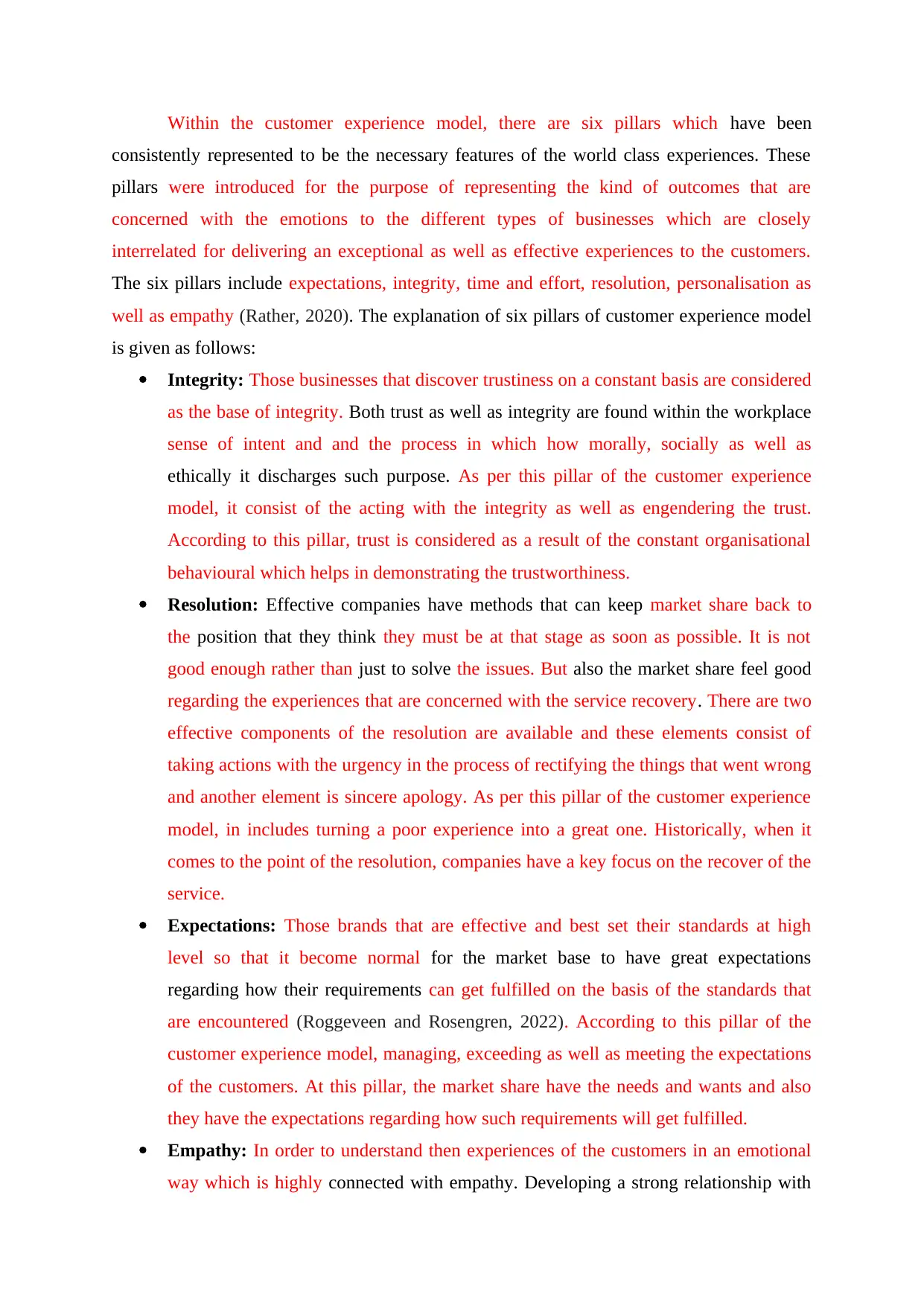
Within the customer experience model, there are six pillars which have been
consistently represented to be the necessary features of the world class experiences. These
pillars were introduced for the purpose of representing the kind of outcomes that are
concerned with the emotions to the different types of businesses which are closely
interrelated for delivering an exceptional as well as effective experiences to the customers.
The six pillars include expectations, integrity, time and effort, resolution, personalisation as
well as empathy (Rather, 2020). The explanation of six pillars of customer experience model
is given as follows:
Integrity: Those businesses that discover trustiness on a constant basis are considered
as the base of integrity. Both trust as well as integrity are found within the workplace
sense of intent and and the process in which how morally, socially as well as
ethically it discharges such purpose. As per this pillar of the customer experience
model, it consist of the acting with the integrity as well as engendering the trust.
According to this pillar, trust is considered as a result of the constant organisational
behavioural which helps in demonstrating the trustworthiness.
Resolution: Effective companies have methods that can keep market share back to
the position that they think they must be at that stage as soon as possible. It is not
good enough rather than just to solve the issues. But also the market share feel good
regarding the experiences that are concerned with the service recovery. There are two
effective components of the resolution are available and these elements consist of
taking actions with the urgency in the process of rectifying the things that went wrong
and another element is sincere apology. As per this pillar of the customer experience
model, in includes turning a poor experience into a great one. Historically, when it
comes to the point of the resolution, companies have a key focus on the recover of the
service.
Expectations: Those brands that are effective and best set their standards at high
level so that it become normal for the market base to have great expectations
regarding how their requirements can get fulfilled on the basis of the standards that
are encountered (Roggeveen and Rosengren, 2022). According to this pillar of the
customer experience model, managing, exceeding as well as meeting the expectations
of the customers. At this pillar, the market share have the needs and wants and also
they have the expectations regarding how such requirements will get fulfilled.
Empathy: In order to understand then experiences of the customers in an emotional
way which is highly connected with empathy. Developing a strong relationship with
consistently represented to be the necessary features of the world class experiences. These
pillars were introduced for the purpose of representing the kind of outcomes that are
concerned with the emotions to the different types of businesses which are closely
interrelated for delivering an exceptional as well as effective experiences to the customers.
The six pillars include expectations, integrity, time and effort, resolution, personalisation as
well as empathy (Rather, 2020). The explanation of six pillars of customer experience model
is given as follows:
Integrity: Those businesses that discover trustiness on a constant basis are considered
as the base of integrity. Both trust as well as integrity are found within the workplace
sense of intent and and the process in which how morally, socially as well as
ethically it discharges such purpose. As per this pillar of the customer experience
model, it consist of the acting with the integrity as well as engendering the trust.
According to this pillar, trust is considered as a result of the constant organisational
behavioural which helps in demonstrating the trustworthiness.
Resolution: Effective companies have methods that can keep market share back to
the position that they think they must be at that stage as soon as possible. It is not
good enough rather than just to solve the issues. But also the market share feel good
regarding the experiences that are concerned with the service recovery. There are two
effective components of the resolution are available and these elements consist of
taking actions with the urgency in the process of rectifying the things that went wrong
and another element is sincere apology. As per this pillar of the customer experience
model, in includes turning a poor experience into a great one. Historically, when it
comes to the point of the resolution, companies have a key focus on the recover of the
service.
Expectations: Those brands that are effective and best set their standards at high
level so that it become normal for the market base to have great expectations
regarding how their requirements can get fulfilled on the basis of the standards that
are encountered (Roggeveen and Rosengren, 2022). According to this pillar of the
customer experience model, managing, exceeding as well as meeting the expectations
of the customers. At this pillar, the market share have the needs and wants and also
they have the expectations regarding how such requirements will get fulfilled.
Empathy: In order to understand then experiences of the customers in an emotional
way which is highly connected with empathy. Developing a strong relationship with
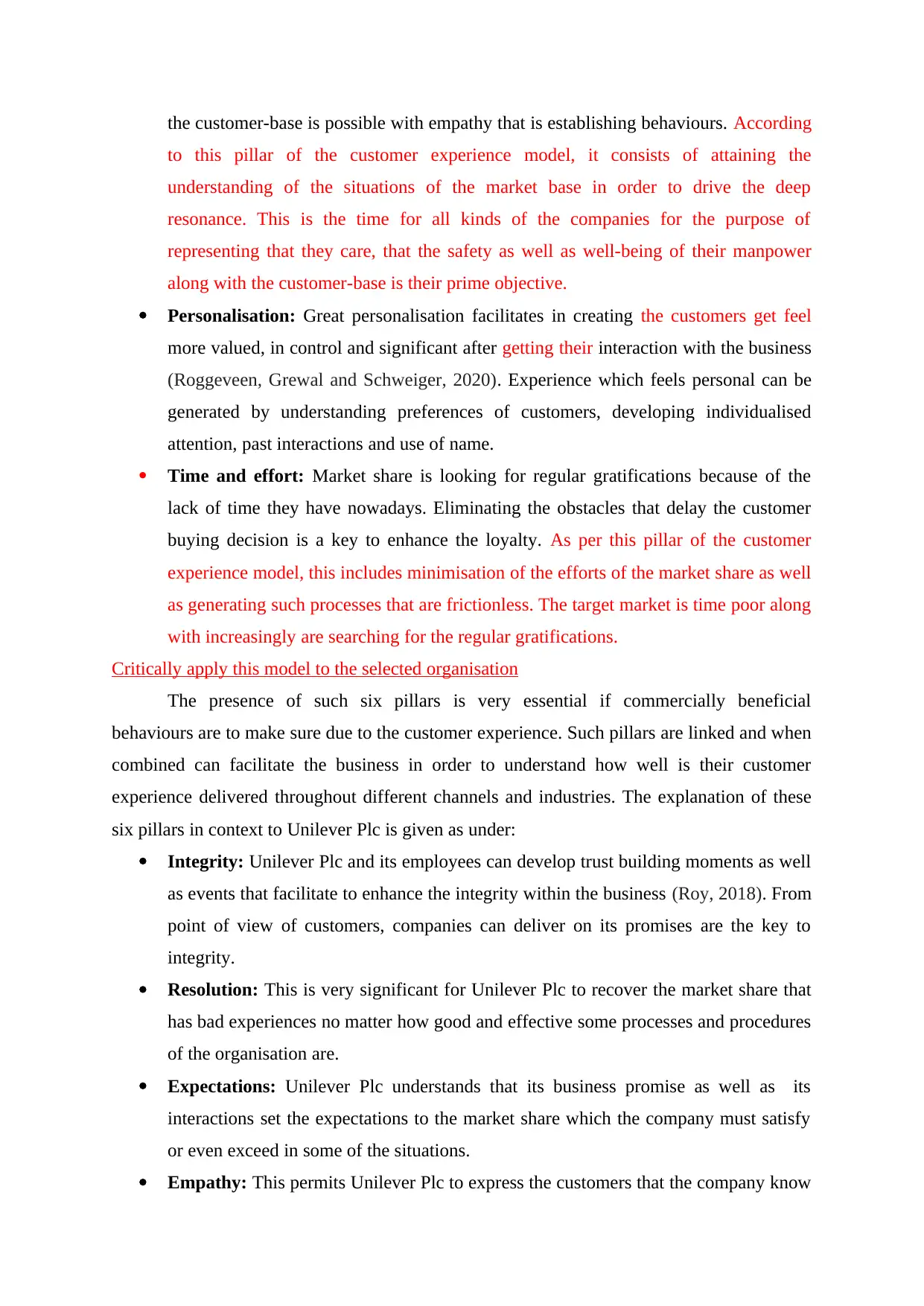
the customer-base is possible with empathy that is establishing behaviours. According
to this pillar of the customer experience model, it consists of attaining the
understanding of the situations of the market base in order to drive the deep
resonance. This is the time for all kinds of the companies for the purpose of
representing that they care, that the safety as well as well-being of their manpower
along with the customer-base is their prime objective.
Personalisation: Great personalisation facilitates in creating the customers get feel
more valued, in control and significant after getting their interaction with the business
(Roggeveen, Grewal and Schweiger, 2020). Experience which feels personal can be
generated by understanding preferences of customers, developing individualised
attention, past interactions and use of name.
Time and effort: Market share is looking for regular gratifications because of the
lack of time they have nowadays. Eliminating the obstacles that delay the customer
buying decision is a key to enhance the loyalty. As per this pillar of the customer
experience model, this includes minimisation of the efforts of the market share as well
as generating such processes that are frictionless. The target market is time poor along
with increasingly are searching for the regular gratifications.
Critically apply this model to the selected organisation
The presence of such six pillars is very essential if commercially beneficial
behaviours are to make sure due to the customer experience. Such pillars are linked and when
combined can facilitate the business in order to understand how well is their customer
experience delivered throughout different channels and industries. The explanation of these
six pillars in context to Unilever Plc is given as under:
Integrity: Unilever Plc and its employees can develop trust building moments as well
as events that facilitate to enhance the integrity within the business (Roy, 2018). From
point of view of customers, companies can deliver on its promises are the key to
integrity.
Resolution: This is very significant for Unilever Plc to recover the market share that
has bad experiences no matter how good and effective some processes and procedures
of the organisation are.
Expectations: Unilever Plc understands that its business promise as well as its
interactions set the expectations to the market share which the company must satisfy
or even exceed in some of the situations.
Empathy: This permits Unilever Plc to express the customers that the company know
to this pillar of the customer experience model, it consists of attaining the
understanding of the situations of the market base in order to drive the deep
resonance. This is the time for all kinds of the companies for the purpose of
representing that they care, that the safety as well as well-being of their manpower
along with the customer-base is their prime objective.
Personalisation: Great personalisation facilitates in creating the customers get feel
more valued, in control and significant after getting their interaction with the business
(Roggeveen, Grewal and Schweiger, 2020). Experience which feels personal can be
generated by understanding preferences of customers, developing individualised
attention, past interactions and use of name.
Time and effort: Market share is looking for regular gratifications because of the
lack of time they have nowadays. Eliminating the obstacles that delay the customer
buying decision is a key to enhance the loyalty. As per this pillar of the customer
experience model, this includes minimisation of the efforts of the market share as well
as generating such processes that are frictionless. The target market is time poor along
with increasingly are searching for the regular gratifications.
Critically apply this model to the selected organisation
The presence of such six pillars is very essential if commercially beneficial
behaviours are to make sure due to the customer experience. Such pillars are linked and when
combined can facilitate the business in order to understand how well is their customer
experience delivered throughout different channels and industries. The explanation of these
six pillars in context to Unilever Plc is given as under:
Integrity: Unilever Plc and its employees can develop trust building moments as well
as events that facilitate to enhance the integrity within the business (Roy, 2018). From
point of view of customers, companies can deliver on its promises are the key to
integrity.
Resolution: This is very significant for Unilever Plc to recover the market share that
has bad experiences no matter how good and effective some processes and procedures
of the organisation are.
Expectations: Unilever Plc understands that its business promise as well as its
interactions set the expectations to the market share which the company must satisfy
or even exceed in some of the situations.
Empathy: This permits Unilever Plc to express the customers that the company know
⊘ This is a preview!⊘
Do you want full access?
Subscribe today to unlock all pages.

Trusted by 1+ million students worldwide
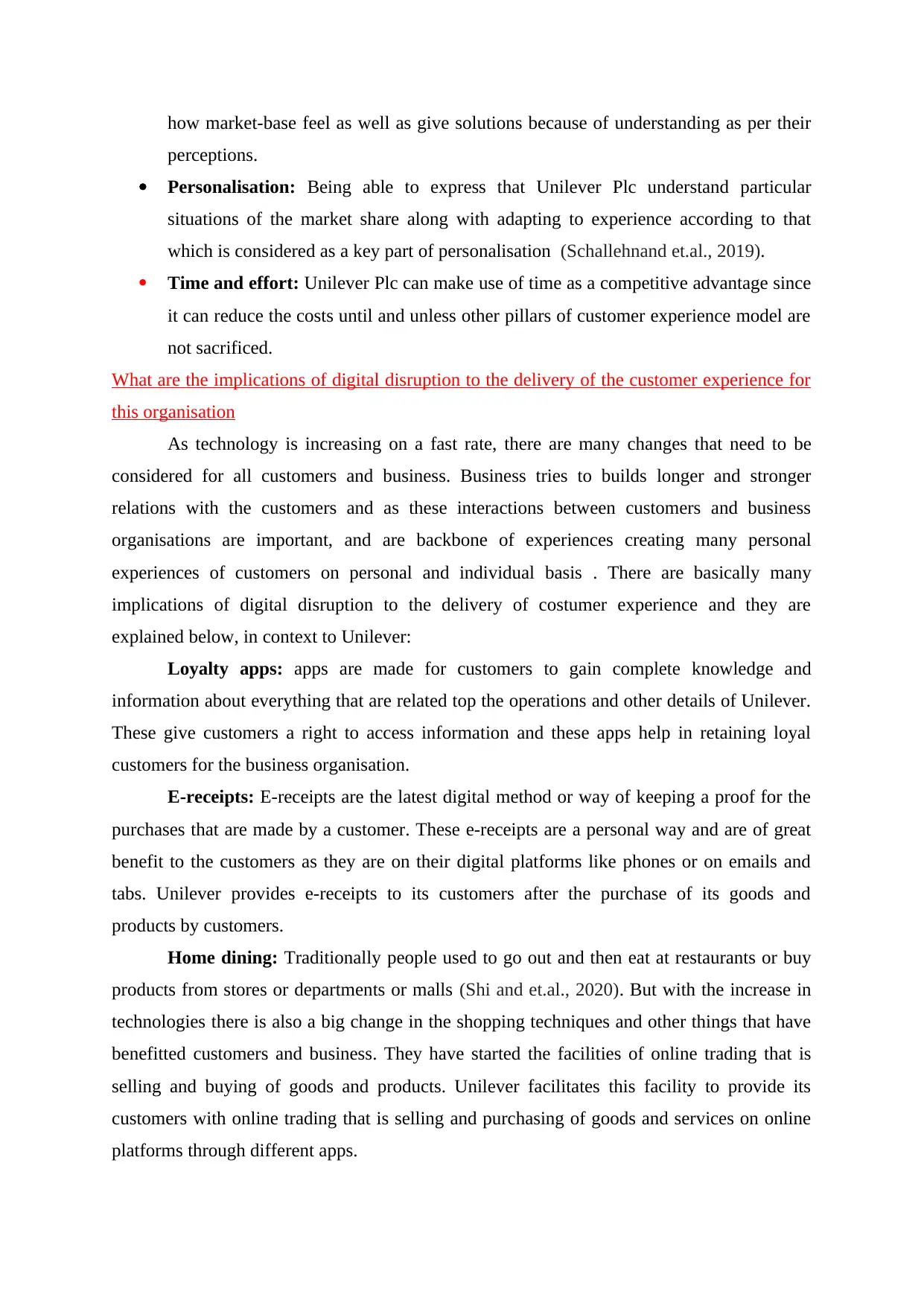
how market-base feel as well as give solutions because of understanding as per their
perceptions.
Personalisation: Being able to express that Unilever Plc understand particular
situations of the market share along with adapting to experience according to that
which is considered as a key part of personalisation (Schallehnand et.al., 2019).
Time and effort: Unilever Plc can make use of time as a competitive advantage since
it can reduce the costs until and unless other pillars of customer experience model are
not sacrificed.
What are the implications of digital disruption to the delivery of the customer experience for
this organisation
As technology is increasing on a fast rate, there are many changes that need to be
considered for all customers and business. Business tries to builds longer and stronger
relations with the customers and as these interactions between customers and business
organisations are important, and are backbone of experiences creating many personal
experiences of customers on personal and individual basis . There are basically many
implications of digital disruption to the delivery of costumer experience and they are
explained below, in context to Unilever:
Loyalty apps: apps are made for customers to gain complete knowledge and
information about everything that are related top the operations and other details of Unilever.
These give customers a right to access information and these apps help in retaining loyal
customers for the business organisation.
E-receipts: E-receipts are the latest digital method or way of keeping a proof for the
purchases that are made by a customer. These e-receipts are a personal way and are of great
benefit to the customers as they are on their digital platforms like phones or on emails and
tabs. Unilever provides e-receipts to its customers after the purchase of its goods and
products by customers.
Home dining: Traditionally people used to go out and then eat at restaurants or buy
products from stores or departments or malls (Shi and et.al., 2020). But with the increase in
technologies there is also a big change in the shopping techniques and other things that have
benefitted customers and business. They have started the facilities of online trading that is
selling and buying of goods and products. Unilever facilitates this facility to provide its
customers with online trading that is selling and purchasing of goods and services on online
platforms through different apps.
perceptions.
Personalisation: Being able to express that Unilever Plc understand particular
situations of the market share along with adapting to experience according to that
which is considered as a key part of personalisation (Schallehnand et.al., 2019).
Time and effort: Unilever Plc can make use of time as a competitive advantage since
it can reduce the costs until and unless other pillars of customer experience model are
not sacrificed.
What are the implications of digital disruption to the delivery of the customer experience for
this organisation
As technology is increasing on a fast rate, there are many changes that need to be
considered for all customers and business. Business tries to builds longer and stronger
relations with the customers and as these interactions between customers and business
organisations are important, and are backbone of experiences creating many personal
experiences of customers on personal and individual basis . There are basically many
implications of digital disruption to the delivery of costumer experience and they are
explained below, in context to Unilever:
Loyalty apps: apps are made for customers to gain complete knowledge and
information about everything that are related top the operations and other details of Unilever.
These give customers a right to access information and these apps help in retaining loyal
customers for the business organisation.
E-receipts: E-receipts are the latest digital method or way of keeping a proof for the
purchases that are made by a customer. These e-receipts are a personal way and are of great
benefit to the customers as they are on their digital platforms like phones or on emails and
tabs. Unilever provides e-receipts to its customers after the purchase of its goods and
products by customers.
Home dining: Traditionally people used to go out and then eat at restaurants or buy
products from stores or departments or malls (Shi and et.al., 2020). But with the increase in
technologies there is also a big change in the shopping techniques and other things that have
benefitted customers and business. They have started the facilities of online trading that is
selling and buying of goods and products. Unilever facilitates this facility to provide its
customers with online trading that is selling and purchasing of goods and services on online
platforms through different apps.
Paraphrase This Document
Need a fresh take? Get an instant paraphrase of this document with our AI Paraphraser
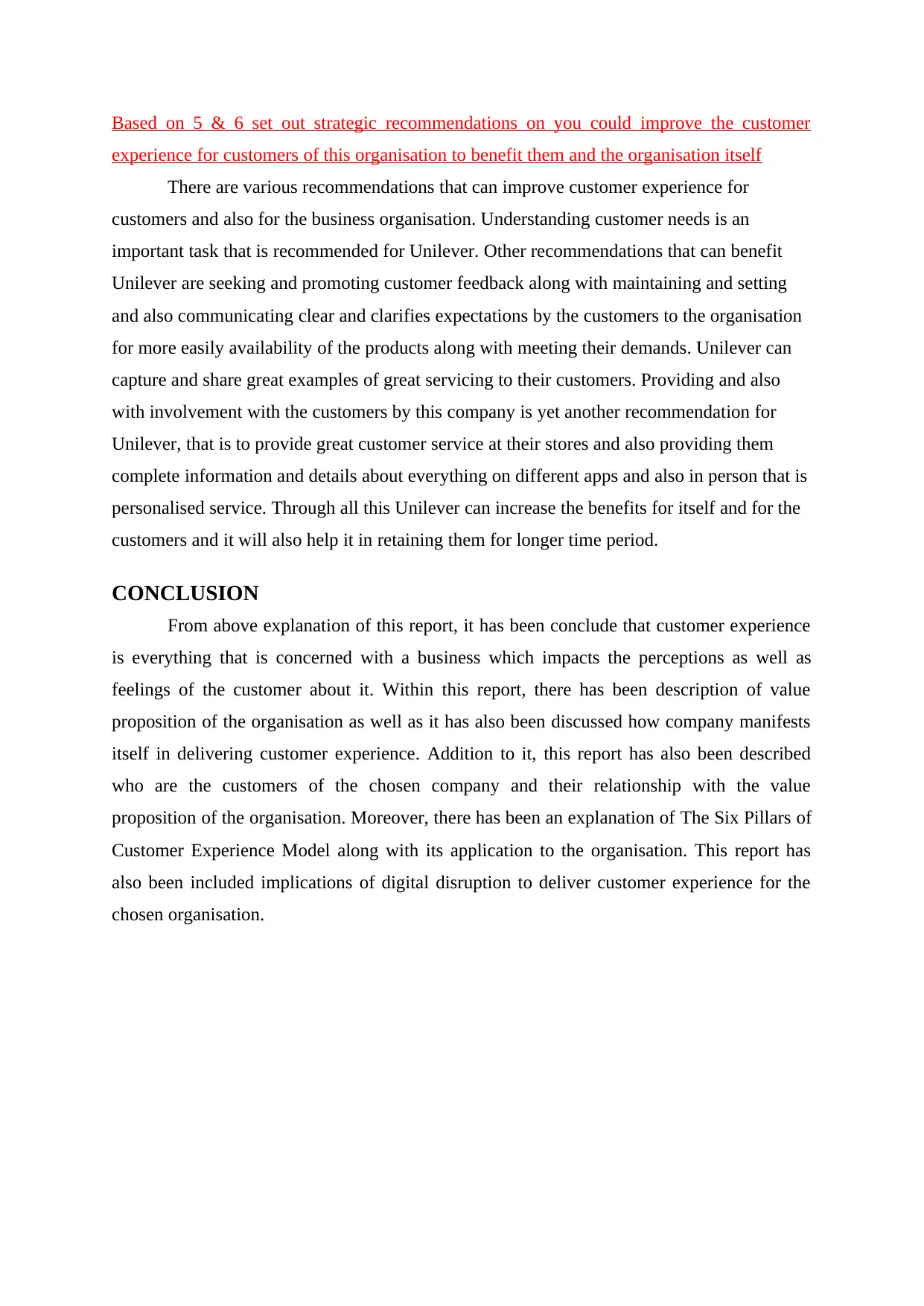
Based on 5 & 6 set out strategic recommendations on you could improve the customer
experience for customers of this organisation to benefit them and the organisation itself
There are various recommendations that can improve customer experience for
customers and also for the business organisation. Understanding customer needs is an
important task that is recommended for Unilever. Other recommendations that can benefit
Unilever are seeking and promoting customer feedback along with maintaining and setting
and also communicating clear and clarifies expectations by the customers to the organisation
for more easily availability of the products along with meeting their demands. Unilever can
capture and share great examples of great servicing to their customers. Providing and also
with involvement with the customers by this company is yet another recommendation for
Unilever, that is to provide great customer service at their stores and also providing them
complete information and details about everything on different apps and also in person that is
personalised service. Through all this Unilever can increase the benefits for itself and for the
customers and it will also help it in retaining them for longer time period.
CONCLUSION
From above explanation of this report, it has been conclude that customer experience
is everything that is concerned with a business which impacts the perceptions as well as
feelings of the customer about it. Within this report, there has been description of value
proposition of the organisation as well as it has also been discussed how company manifests
itself in delivering customer experience. Addition to it, this report has also been described
who are the customers of the chosen company and their relationship with the value
proposition of the organisation. Moreover, there has been an explanation of The Six Pillars of
Customer Experience Model along with its application to the organisation. This report has
also been included implications of digital disruption to deliver customer experience for the
chosen organisation.
experience for customers of this organisation to benefit them and the organisation itself
There are various recommendations that can improve customer experience for
customers and also for the business organisation. Understanding customer needs is an
important task that is recommended for Unilever. Other recommendations that can benefit
Unilever are seeking and promoting customer feedback along with maintaining and setting
and also communicating clear and clarifies expectations by the customers to the organisation
for more easily availability of the products along with meeting their demands. Unilever can
capture and share great examples of great servicing to their customers. Providing and also
with involvement with the customers by this company is yet another recommendation for
Unilever, that is to provide great customer service at their stores and also providing them
complete information and details about everything on different apps and also in person that is
personalised service. Through all this Unilever can increase the benefits for itself and for the
customers and it will also help it in retaining them for longer time period.
CONCLUSION
From above explanation of this report, it has been conclude that customer experience
is everything that is concerned with a business which impacts the perceptions as well as
feelings of the customer about it. Within this report, there has been description of value
proposition of the organisation as well as it has also been discussed how company manifests
itself in delivering customer experience. Addition to it, this report has also been described
who are the customers of the chosen company and their relationship with the value
proposition of the organisation. Moreover, there has been an explanation of The Six Pillars of
Customer Experience Model along with its application to the organisation. This report has
also been included implications of digital disruption to deliver customer experience for the
chosen organisation.
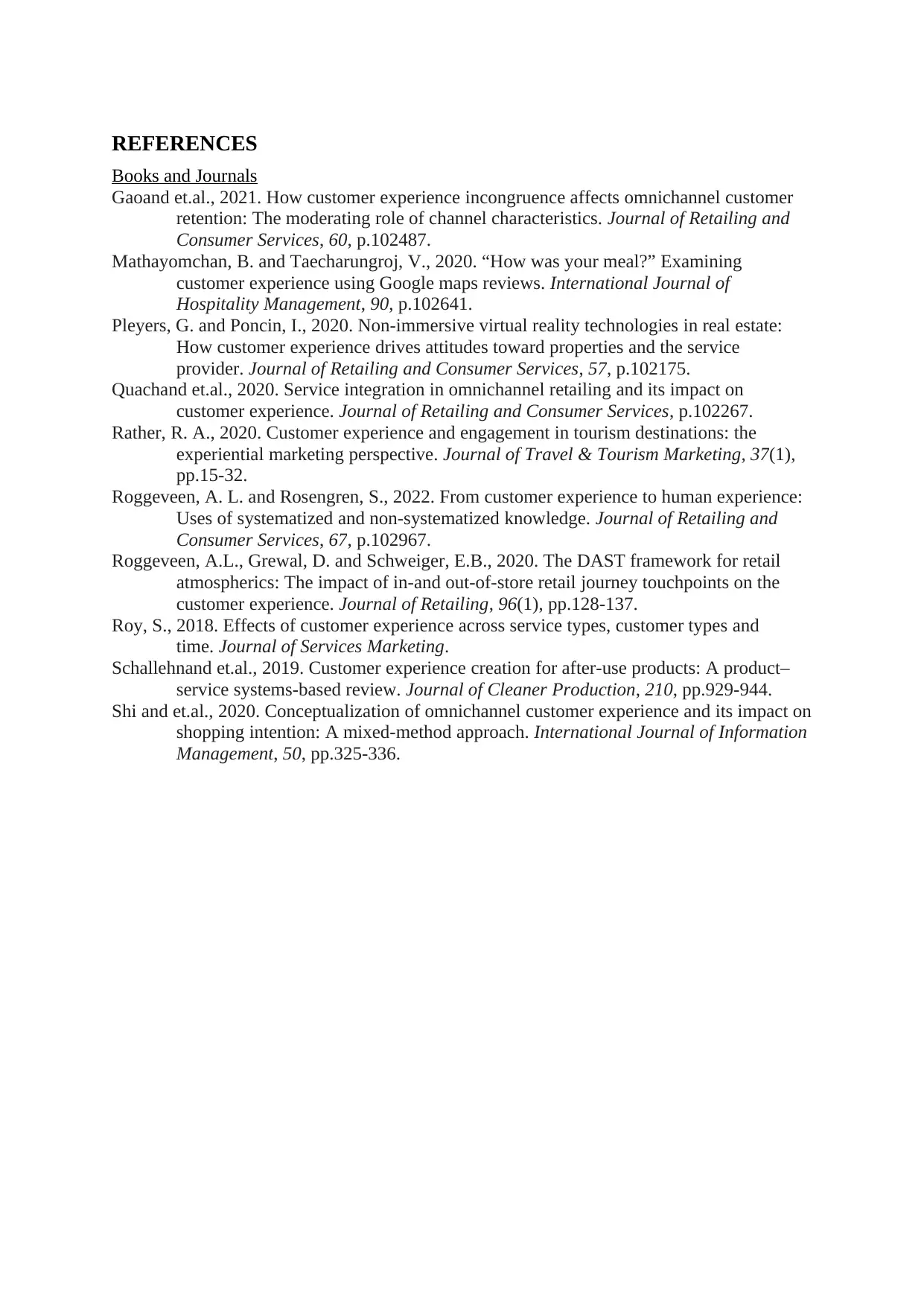
REFERENCES
Books and Journals
Gaoand et.al., 2021. How customer experience incongruence affects omnichannel customer
retention: The moderating role of channel characteristics. Journal of Retailing and
Consumer Services, 60, p.102487.
Mathayomchan, B. and Taecharungroj, V., 2020. “How was your meal?” Examining
customer experience using Google maps reviews. International Journal of
Hospitality Management, 90, p.102641.
Pleyers, G. and Poncin, I., 2020. Non-immersive virtual reality technologies in real estate:
How customer experience drives attitudes toward properties and the service
provider. Journal of Retailing and Consumer Services, 57, p.102175.
Quachand et.al., 2020. Service integration in omnichannel retailing and its impact on
customer experience. Journal of Retailing and Consumer Services, p.102267.
Rather, R. A., 2020. Customer experience and engagement in tourism destinations: the
experiential marketing perspective. Journal of Travel & Tourism Marketing, 37(1),
pp.15-32.
Roggeveen, A. L. and Rosengren, S., 2022. From customer experience to human experience:
Uses of systematized and non-systematized knowledge. Journal of Retailing and
Consumer Services, 67, p.102967.
Roggeveen, A.L., Grewal, D. and Schweiger, E.B., 2020. The DAST framework for retail
atmospherics: The impact of in-and out-of-store retail journey touchpoints on the
customer experience. Journal of Retailing, 96(1), pp.128-137.
Roy, S., 2018. Effects of customer experience across service types, customer types and
time. Journal of Services Marketing.
Schallehnand et.al., 2019. Customer experience creation for after-use products: A product–
service systems-based review. Journal of Cleaner Production, 210, pp.929-944.
Shi and et.al., 2020. Conceptualization of omnichannel customer experience and its impact on
shopping intention: A mixed-method approach. International Journal of Information
Management, 50, pp.325-336.
Books and Journals
Gaoand et.al., 2021. How customer experience incongruence affects omnichannel customer
retention: The moderating role of channel characteristics. Journal of Retailing and
Consumer Services, 60, p.102487.
Mathayomchan, B. and Taecharungroj, V., 2020. “How was your meal?” Examining
customer experience using Google maps reviews. International Journal of
Hospitality Management, 90, p.102641.
Pleyers, G. and Poncin, I., 2020. Non-immersive virtual reality technologies in real estate:
How customer experience drives attitudes toward properties and the service
provider. Journal of Retailing and Consumer Services, 57, p.102175.
Quachand et.al., 2020. Service integration in omnichannel retailing and its impact on
customer experience. Journal of Retailing and Consumer Services, p.102267.
Rather, R. A., 2020. Customer experience and engagement in tourism destinations: the
experiential marketing perspective. Journal of Travel & Tourism Marketing, 37(1),
pp.15-32.
Roggeveen, A. L. and Rosengren, S., 2022. From customer experience to human experience:
Uses of systematized and non-systematized knowledge. Journal of Retailing and
Consumer Services, 67, p.102967.
Roggeveen, A.L., Grewal, D. and Schweiger, E.B., 2020. The DAST framework for retail
atmospherics: The impact of in-and out-of-store retail journey touchpoints on the
customer experience. Journal of Retailing, 96(1), pp.128-137.
Roy, S., 2018. Effects of customer experience across service types, customer types and
time. Journal of Services Marketing.
Schallehnand et.al., 2019. Customer experience creation for after-use products: A product–
service systems-based review. Journal of Cleaner Production, 210, pp.929-944.
Shi and et.al., 2020. Conceptualization of omnichannel customer experience and its impact on
shopping intention: A mixed-method approach. International Journal of Information
Management, 50, pp.325-336.
⊘ This is a preview!⊘
Do you want full access?
Subscribe today to unlock all pages.

Trusted by 1+ million students worldwide
1 out of 9
Related Documents
Your All-in-One AI-Powered Toolkit for Academic Success.
+13062052269
info@desklib.com
Available 24*7 on WhatsApp / Email
![[object Object]](/_next/static/media/star-bottom.7253800d.svg)
Unlock your academic potential
Copyright © 2020–2025 A2Z Services. All Rights Reserved. Developed and managed by ZUCOL.



